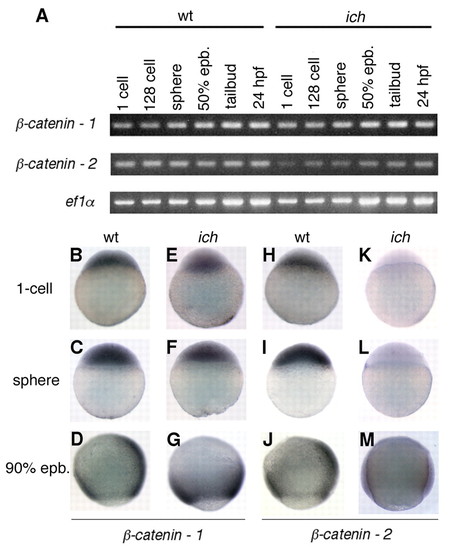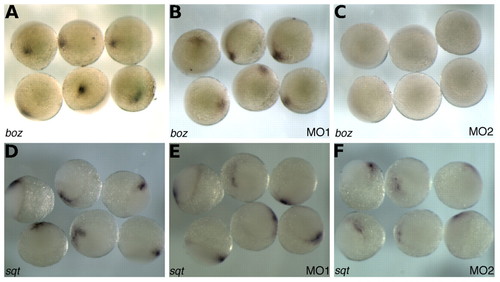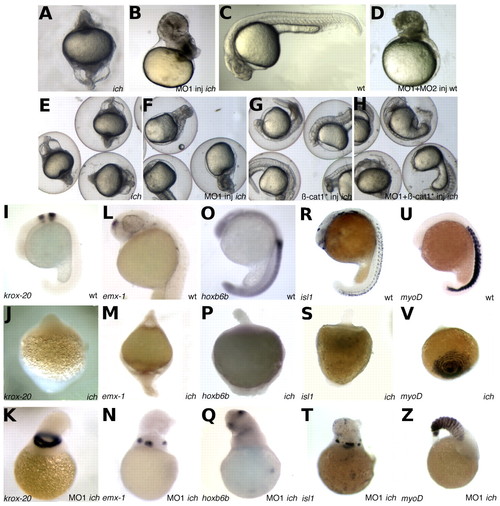- Title
-
Essential and opposing roles of zebrafish ?-catenins in the formation of dorsal axial structures and neurectoderm
- Authors
- Bellipanni, G., Varga, M., Maegawa, S., Imai, Y., Kelly, C., Myers, A.P., Chu, F., Talbot, W.S., and Weinberg, E.S.
- Source
- Full text @ Development
|
Maternal β-catenin-2 transcript is reduced in ichabod embryos. (A) RT-PCR assay of RNA expression levels in wild-type and ichabod embryos. For each stage shown, oligo dT-primed cDNA was used as a template for three separate PCR amplifications using primers for β-catenin-1, β-catenin-2 and ef1α. Maternal β-catenin-2 transcript was reduced in ichabod embryos, but reduction of maternal β-catenin-1 transcript or zygotic transcripts of either gene was not observed. (B-M) Whole-mount in situ hybridization showing ubiquitous expression of both β-catenin genes and low expression of maternal β-catenin-2. One-cell stage (top row: B,E,H,K), sphere stage (middle row: C,F,I,L) and 90% epiboly (bottom row: D,G,J,M) wild-type (B-D, H-J) and ichabod (E-G, K-M) embryos were tested for expression of β-catenin-1 (B-G) and β-catenin-2 (H-M). Embryos in D,J are shown in lateral view with dorsal towards the right. |
|
Injection of morpholino antisense oligonucleotides (MOs) directed against the translational initiation site of β-catenin-2 can phenocopy the ichabod mutation, whereas MOs against β-catenin-1 have no ventralizing effect. (A-C) Effect of injection of MO1 into wild-type embryos. Injection of 1 mM MO1 often results in a slight necrosis in the head (B) and 3 mM MO1 causes more severe necrosis and bent shortened tails (C), but in neither case were the embryos ventralized. A wild-type embryo at the same stage is shown for comparison (A). (D-G) Effect of injection of MO2 into wild-type embryos. Examples of Class 2 (E) and Class 1 (F) embryos obtained by injecting wild-type embryos with 3 mM MO2 are compared with a wild-type embryo (D) and an embryo injected with 3 mM MO2mis (G). (H) The effects of injection of 3 mM MO2 can be rescued by co-injection of β-catenin-2* RNA (β-catenin-2 RNA with an altered ribosome binding region that will not bind to MO2). Injection of 3 mM MO2 alone yielded a distribution of ventralized phenotypes (red bars). Injection of β-catenin-2* RNA alone had no ventralizing effect (compare green and yellow bars). Co-injection of MO2 and the RNA yielded mostly wild-type-appearing embryos, with only a few embryos exhibiting weak ventralization (blue bars). In this experiment, we classified non-ventralized embryos into two classes, wild-type and C5, with C5 embryos exhibiting kinky notochords. (I) Injection of MO2 into ichabod embryos shifted the phenotypic distribution to more-severe ventralized classes. PHENOTYPE:
|
|
β-catenin-2, but not β-catenin-1, is required for normal expression of the early dorsal markers bozozok and squint. Wild-type embryos were injected with 3 mM MO1 (B,E) or 3 mM MO2 (C,F) and compared with uninjected embryos (A,D) for bozozok (A-C) and squint (D-F) expression at 30% epiboly stage. bozozok expression is inhibited by MO2 and squint expression is partially inhibited by MO2; MO1 injection has no effect on expression of these two markers. EXPRESSION / LABELING:
|
|
A new phenotype (`ciuffo') results from loss of function of both β-catenin genes. (A-D) The `ciuffo' phenotype is apparent in ichabod embryos injected with 3 mM MO1 (B) and wild-type embryos injected with 3 mM MO1 and 3 mM MO2 (D). Uninjected ichabod (A) and wild-type (C) embryos are shown for comparison. (E-H) Co-injection of β-catenin-1* RNA (β-catenin-1 RNA with an altered ribosome binding region that will not bind to MO1) into ichabod embryos can suppress the `ciuffo' phenotype produced by MO1 injection. In comparison with uninjected ichabod embryos, which develop to C1 phenotypes (E), injection of 1 mM MO1 transforms approximately two-thirds of the embryos into `ciuffo' phenotypes (F), injection of the RNA alone causes rescue to wild-type and less ventralized C2-C4 phenotypes (G), but co-injection of both MO1 and RNA results in embryos with the original severe C1 phenotype and with C1a phenotype (H). Each of these panels shows a group of representative embryos of one of four repeats of this experiment, which all gave consistent results. (I-Z) Hindbrain and anterior neural markers and neuronal markers are not expressed in ichabod embryos (J,M,S) but are expressed in 3 mM MO1-injected ichabod (`ciuffo') embryos (K,N,T). The posterior neural marker hox6b6 is expressed in some ichabod embryos (P) and in `ciuffo' embryos (Q). Wild-type embryos are shown as positive controls (I,L,O,R). The following probes were used: krox20 (I-K), emx1 (L-N), hoxb6b (O-Q) and islet1 (R-T). All three types of embryos express myoD (U-Z), although the expression is radialized in both ichabod (V) and `ciuffo' (Z) embryos compared with wild type (U). Embryos in A-H and L-N are at 24 hpf and those in I-K,O-V are at 22 hpf. For I-Z, probes are indicated in the lower left corner and type of embryo in the lower right corner of each panel. EXPRESSION / LABELING:
PHENOTYPE:
|
|
β-Catenin-1 and β-catenin-2 function redundantly to repress expression of chordin and goosecoid, but not bozozok or squint. Wild-type A,D,G,J,M,P), ichabod (B,E,H,K,N,Q) or MO1-injected ichabod (C,F,I,L,O,R) embryos were assayed for expression of boz (A-C), sqt (D-F), gsc (G-L) or chd (M-R) at 30% epiboly (A-I,M-O) or 50% epiboly (J-L,P-R). MO1-injected and non-injected ichabod embryos of the same embryo clutch were compared for each marker. All embryos are shown in animal pole views. EXPRESSION / LABELING:
|





